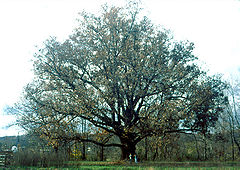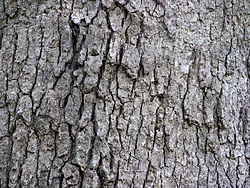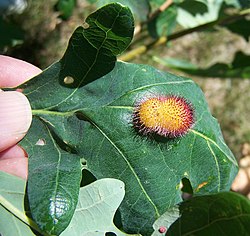White oak
| Quercus alba subsp. var. | White oak | |||||||||||||||||||||||||||||||||||||||||||||||||||||||
|---|---|---|---|---|---|---|---|---|---|---|---|---|---|---|---|---|---|---|---|---|---|---|---|---|---|---|---|---|---|---|---|---|---|---|---|---|---|---|---|---|---|---|---|---|---|---|---|---|---|---|---|---|---|---|---|---|

|
|
| ||||||||||||||||||||||||||||||||||||||||||||||||||||||
| ||||||||||||||||||||||||||||||||||||||||||||||||||||||||
Quercus alba, the white oak, is one of the pre-eminent hardwoods of eastern North America. It is a long-lived oak in the family Fagaceae, native to eastern North America, from southern Quebec west to eastern Minnesota, and south to northern Florida and eastern Texas. Specimens are known to have lived over 600 years. The oldest tree in North Carolina is a white oak found at Tanglewood Park.
Although called the white oak, it is very unusual to find an individual specimen with white bark; the usual color is a light gray. In the forest it reaches a magnificent height. In the open it develops into a massive broad-topped tree with great limbs striking out at wide angles.[1]
Normally not a very tall tree, typically 65–85 feet (19.5-25.5 m) tall at maturity, it nonetheless becomes quite massive and its lower branches are apt to reach far out laterally parallel to the ground. The tallest known white oak is 144 feet (43 m) tall. It is not unusual for a white oak tree to be as wide as it is tall. Conversely, specimens at high altitude may only be small shrubs. White oaks have been known to live up to six hundred years. The bark is a light ash-gray and somewhat peeling, variously from the top, bottom and/or sides.
In spring the young leaves are exquisite in their delicate silvery pink, covered with soft down as with a blanket. The petioles are short, and the leaves which cluster close to the ends of the shoots are pale green and downy with the result that the entire tree has a misty, frosty look which is very beautiful. This lovely vision continues for several days passing through the opalescent changes of soft pink, silvery white and finally yellow green.[1]
The leaves grow to 5-8.5 in long and 2.75-4.5 in broad, with a deep glossy green upper surface. The leaves usually turn red or brown in autumn, but depending on climate, site, and individual tree genetics, some trees are nearly always red, or even purple in autumn, others turn straight to a brown. Some brown, dead leaves may remain on the tree throughout winter until very early spring. They are variably lobed; sometimes the lobes are shallow, extending less than half-way to the midrib, but sometimes they are deeply lobed, with the lobes somewhat branching. The acorns are usually sessile, and grow to .5-1 in long, falling in early October.
It is sometimes confused with the swamp white oak, a closely-related species, and the bur oak. The white oak hybridizes freely with the bur oak, the post oak, and the chestnut oak.[1]
- Bark: Light gray, varying to dark gray and to white; shallow fissured and scaly. Branchlets at first bright green, later reddish-green and finally light gray. A very distinguishing feature of this tree is that a little over half way up the tree the bark tends to become platy, that is that it looks sort of like overlapping scales that are easy to see and make this tree easy to identify.
- Wood: Light brown with paler sapwood; strong, tough, heavy, fine-grained, durable and beautiful. Specific gravity, 0.7470; weight of cubic foot, 46.35 lbs; weight of cubic meter 770 kg.[2]
- Winter buds: Reddish brown, obtuse, one-eighth of an inch long.
- Leaves: Alternate, five to nine inches long, three to four inches wide. Obovate or oblong, seven to nine-lobed, usually seven-lobed with rounded lobes and rounded sinuses; lobes destitute of bristles; sinuses sometimes deep, sometimes shallow. On young trees the leaves are often repand. They come out of the bud conduplicate, bright red above, pale below and covered with white tomentum; the red faded quickly and they become silvery greenish white and shining; when full grown are thin, bright yellow green, shining or dull above, pale, glaucous or smooth below; midrib stout, yellow, primary veins conspicuous. In late autumn they turn a deep red and drop, or on young trees remain on the branches throughout the winter. Petioles short, stout, grooved, and flattened. Stipules linear, caducous.
- Flowers: May, when leaves are one-third grown. Staminate flowers borne in hairy aments two and a half to three inches lone; calyx bright yellow, hairy, six to eight-lobed, lobes shorter than the stamens; anthers yellow. Pistillate flowers borne on short peduncles; involucral scales hairy, reddish; calyx lobes acute; stigmas bright red.
- Acorns: Annual, sessile or stalked; nut ovoid or oblong, round at the apex, light brown, shining, three-quarters to an inch long; cup cup-shaped, encloses about one-fourth of the nut, tomentose on the outside, tuberculate at base, scales with short obtuse tips becoming smaller and thinner toward the rim.[1]
Cultivation
The white oak makes an outstanding shade tree, with an exceptionally wide spread and almost never dropping limbs. However, it does not tolerate urban conditions well, due to an intolerance of soil compaction and changes in soil levels. It may thrive in residential neighborhoods where protected from such change.
Propagation
Pests and diseases
Varieties
Gallery
References
- ↑ 1.0 1.1 1.2 1.3 Keeler, Harriet L. (1900). Our Native Trees and How to Identify Them. New York: Charles Scriber's Sons. pp. 328–332. ISBN 0873388380.
- ↑ Niche Timbers White Oak
- Standard Cyclopedia of Horticulture, by L. H. Bailey, MacMillan Co., 1963
External links
- w:White oak. Some of the material on this page may be from Wikipedia, under the Creative Commons license.
- White oak QR Code (Size 50, 100, 200, 500)




